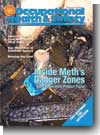
November 2006
- Inside Meth's Danger Zones
- Coal Mine Safety After Sago
- Selecting Respirators with Confidence
- Safety Considerations for Live Electrical Measurements
Click here to subscribe.
Cover Story
By Geoff Betsinger, MS, CIH
ONE of the most significant challenges today faced by law enforcement and professional cleaning companies is methamphetamine laboratory seizure and cleanup. These makeshift and chemically "dirty" facilities pose real health risks for those required to enter and clean these areas.
Features
By Jerry Laws
ACHIEVING safety excellence in mining is neither easy nor inexpensive, but sometimes it can be done relatively fast. St. Louis-based Peabody Energy has won four Sentinels of Safety awards, many Holmes Safety Association awards, and numerous federal and state mine rescue champion's trophies in the past decade, but its safety record was so-so as recently as 1990, said Dave Beerbower, the coal company's vice president of safety for the past 14 years.
By Jerry Laws
Safety in U.S. coal mines has been a front-burner issue since a methane explosion killed 12 miners Jan. 2, 2006, inside the Sago Mine, located near Buckhannon in Upshur County, W.Va. That incident sparked the MINER Act, an important reform of federal mine safety regulations; a 101-page report delivered in July 2006 to West Virginia Gov. Joe Manchin III; and an independent, 10-member commission of experts created by the National Mining Association to examine mine safety technology and training.
By Raymond Wagner II
FRANCIS Bacon, a philosopher, once said that "knowledge is power." While this saying can be applied to many different situations throughout life, it has added value when talking about confined spaces in the work area. It's important to have a knowledge and understanding of confined spaces because the lack of same could result in serious injury, including death.
By Bill Smith
WHEN monitoring the atmosphere in a confined space, there are several important issues that need to be considered, reviewed, and managed. One of the major issues centers on air quality and what you are breathing, both prior to entry and during occupation of a confined space. You need to know what the oxygen content of the atmosphere is and whether there are explosive or toxic gases that could threaten the safety of the environment or, perhaps more importantly, your life.
By Michael P. Toohey
FIRE safety is of monumental importance to building owners and managers, individuals whose fire protection decisions affect both life safety and the preservation of valuable assets. There is a variety of products available to these decision makers to ensure their buildings are properly protected.
By Vivian Isaak
IN the United States, the leading cause of death and debilitating injury to children over the age of one is motor vehicle accidents. Impelled by this bleak statistic, The Children's Hospital of Philadelphia® and State Farm® Mutual Automobile Insurance Companies formed Partners for Child Passenger Safety (PCPS) in 1997 as a program of the Hospital's Center for Injury Research and Prevention.
By Judie Smithers
HAVE you ever cringed to see someone wearing a filtering facepiece for protection from exposure to organic vapors? The worker probably thought one respirator was as good as another. Misunderstandings in respirator selection can lead to overexposures and illness.
By Ronnie Rittenberry
WE interrupt this issue for an important seasonal report. The arctic winter air sweeping across the country within the next few months brings hazards most workers do not have to face the rest of the year. Slips and falls, road accidents caused by ice and snow, and carbon monoxide poisonings from faulty furnaces and automobiles all have elevated incident rates during the winter.
By Duane Smith
MEASURING live voltages and current in today's high-energy environments can result in a severe hazard to equipment and users if proper precautions are not applied. Given the risk of transients, surges, and old-fashioned human error, it always pays to follow safe work practices and use test instruments rated for the voltage or current you're measuring.
Departments
By Mark A. Lies
UNFORTUNATELY, many employers eventually will have to deal with a hostile employee who may threaten co-employees with verbal and non-verbal conduct. There are a number of actions the employer should consider to protect the employees at the workplace, as well as the physical security of the facility.
By Marc Barrera
MATERIAL Safety Data Sheets are just one element of a large periodical table of safety regulations with which employers must comply to best ensure workers' safety. On the surface it may appear a simple, singular task, but it can easily grow into a giant, complicated mess. The common practice still in use today for many companies is to keep hard copies of the sheets on hand in three-ring notebook binders. Many hours are spent updating these notebooks; despite an employer's best efforts, the results can become cumbersome binders filled with outdated or poor, fax-quality sheets that can become lost, torn, or covered in smudges and dirt.
By Jerry Laws
ONE year ago in this space, I invited you to read Australia's Proposed National Code of Practice for the Prevention of Falls in General Construction because it intended to eliminate fall hazards during the design stage of structures, if possible. This month, another Australian safety success story is mentioned in our pages.